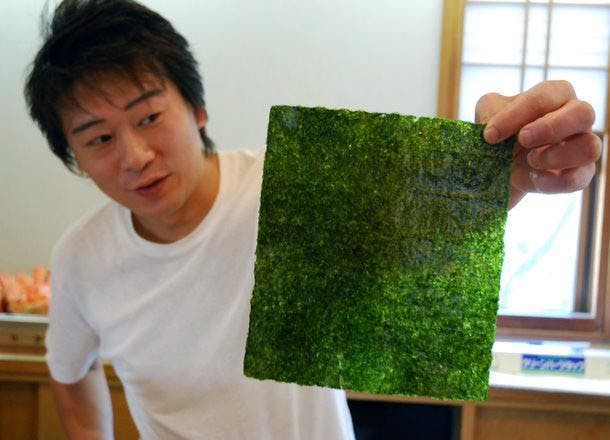
what makes good nori good?
Discover the secrets of making top grade nori seaweed as a nori maker along the Ariake Sea shares the qualities that make his product stand out. From the satisfying briny aroma to the audible crunch and smooth texture, learn why top quality nori is highly sought after by chefs in Japan and beyond.
After visiting nori seaweed farmers along the Ariake Sea, I wondered, naturally, about the final product. What is it exactly that makes good nori good?
To find out I hopped a train the following day to visit the area's top nori maker -- a man who collects the harvest and presses it into the paper-thin sheets that wrap maki rolls. He drove me and my friend Atsushi to a small workshop and warehouse attached to his home in a village along the Ariake coast, a workshop silent now because the nori making season is still a couple of months away. Why is his seaweed considered top grade?
The nori maker pulled a cardboard box from a stack and carefully tore open a foil-lined paper bag inside. It was filled with bundles of forest-green sheets of nori held together with paper bands. The maker put his nose to it and inhaled deeply. The sheets gave off a satisfying briny aroma, like the sea. "This is my finest nori," the maker said. He produced this batch especially for the CEO of a giant corporation. He slipped a sheet out of a bundle and turned to us. "Listen," he said.
The maker folded the sheet in half, then folded it again. With each crease, the nori emitted a loud crunch that sounded like the snap of a crisp tortilla, a crunch so audible it seemed almost unreal, like a Foley effect in a movie. "Pari pari," he said in Japanese -- the crunch -- is key. "Now look," he said.
He held up a sheet to the light. See the surface? "Smooth like a baby," he said, answering his own question. "Lesser quality nori looks like grandma's skin." He pulled more sheets from the box and passed them to me, Atsushi, and his family, which had gathered around. "Now taste," he said.
We tore bites from the sheet and crunched them loudly. A curious thing happened: The nori quickly dissolved in our mouths. "After the crunch, that melting in your mouth is another sign of top quality nori," the maker explained.
He sends his Ariake nori to restaurants all over Japan, even as far north as Hokkaido (the northern-most island), the maker told us. I asked him if I could buy some for my friend and teacher Chef Ono in New York. "My nori is not for sale," he answered -- his entire inventory has been called for. But the maker graciously handed me a bundle of sheets as I headed back to the train. A gift. "Let me know what the chef thinks about my nori."
